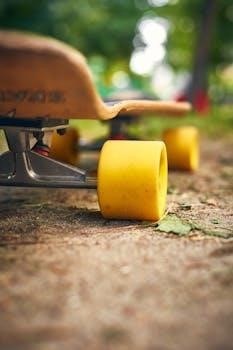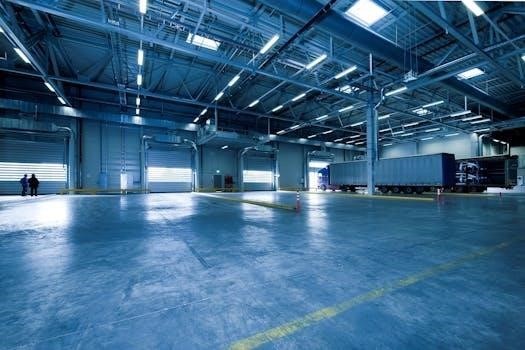skate truck size guide
Confused about skate truck sizes? Our ultimate skate truck size guide will help you choose the right trucks for your board and riding style. Get rolling!
Skateboard Truck Size Guide

Choosing the right skateboard trucks can be confusing․ This guide simplifies truck selection, focusing on size․ Matching your trucks to your board is vital for optimal performance․ This ensures stability, prevents wheel bite, and enhances your overall skateboarding experience․
Skateboard trucks are a crucial component, acting as the vital connection between your deck and wheels․ They profoundly influence your board’s turning, stability, and overall performance․ Selecting the right trucks is essential for a satisfying skateboarding experience․ Trucks aren’t just metal parts; they’re the heart of your board, translating your movements into action․
Think of them as the axle of your skateboard, controlling how you turn, ollie, and grind․ Choosing the correct trucks ensures a smooth and responsive ride, while the wrong ones can hinder your progress․ Understanding the basics of skateboard trucks is the first step toward building a custom skateboard tailored to your style․
This guide will walk you through everything you need to know about skateboard trucks․ We’ll cover sizes, styles, materials, and other considerations, ensuring you choose the perfect pair for your needs․ With the right knowledge, you can confidently select trucks that enhance your skateboarding journey․
Importance of Correct Truck Size
Selecting the correct truck size is paramount for optimal skateboard performance․ Trucks that are too narrow can lead to instability․ Conversely, trucks that are too wide can cause unwanted shoe-to-wheel contact, hindering your ride․ The right size provides a balanced and responsive feel․ Matching truck width to deck width is the key․
Imagine trying to balance on a seesaw with uneven weight distribution․ That’s what it feels like to ride with improperly sized trucks․ A well-matched truck size ensures stability, allowing you to confidently execute tricks and navigate various terrains․ This prevents wobbling, making learning easier․
Furthermore, the correct truck size optimizes turning ability and control․ By choosing the right size, you’ll enhance your skateboarding experience and progress faster․ This is because a correctly sized truck translates your movements more efficiently․ Ultimately, selecting the right truck size creates a seamless connection between you and your board․
Measuring Your Skateboard Deck Width

Accurately measuring your skateboard deck width is the crucial first step in selecting the correct trucks․ Knowing this dimension ensures a proper fit, maximizing your board’s performance and your control․ The width is typically measured in inches, at the widest point of the deck․
To measure, use a ruler or measuring tape․ Place it across the deck, perpendicular to the length, at its widest point․ Ensure you’re measuring from edge to edge, not just the flat surface․ Record the measurement to the nearest tenth of an inch․ This precise measurement will guide your truck selection process․
If you don’t have a measuring tool, you can often find the deck width printed on the board itself, usually near the tail or under the grip tape․ Once you have the deck width, you can consult a truck size chart․ This matching ensures a stable and responsive ride․
Understanding Truck Width Measurements

Skateboard truck width measurements are essential for ensuring a proper fit with your deck․ These measurements are typically given in millimeters (mm) and inches, referring to the axle width and hanger width․ The axle width is the total width of the axle, including the portions that extend beyond the hanger․
The hanger width, on the other hand, is the distance between the inner edges of the truck’s hanger; It’s the part that primarily aligns with the deck’s width․ When selecting trucks, focus on matching the hanger width to your deck width for optimal stability and control․
A truck that is too narrow will feel unstable, while a truck that is too wide can cause wheel bite․ Manufacturers often provide charts that correlate deck width to recommended truck sizes․ Understanding these measurements allows you to make informed decisions․ This ensures the best possible skateboarding experience․
Truck Size Chart⁚ Matching Trucks to Deck Width
Selecting the correct skateboard truck size is crucial for optimal performance, stability, and control․ A truck size chart provides a guideline to match the truck width to the deck width․ This ensures a balanced setup․ Typically, the deck width is measured in inches, and the truck width corresponds to this measurement, also usually specified in inches or millimeters․
For instance, a deck that is 7․75 inches wide generally pairs well with trucks that have an axle width around 5․0 inches․ An 8․0-inch deck usually matches with a 5․25-inch truck․ These are general recommendations․ Slight variations may occur based on personal preference and the specific brand of trucks․
Consulting a truck size chart helps avoid issues like instability from trucks that are too narrow, or wheel bite from trucks that are too wide․ Always refer to the manufacturer’s specifications for the most accurate fit․ This helps you dial in your skateboard setup perfectly․
Truck Height (Profile) Explained⁚ Low, Mid, High
Skateboard truck height, often referred to as the profile, plays a significant role in your board’s performance and feel․ Trucks are generally categorized into three height profiles⁚ low, mid, and high․ Each profile caters to different skating styles and wheel sizes․
Low trucks are designed for enhanced stability and are commonly paired with smaller wheels (50-53mm)․ They offer a lower center of gravity, making flip tricks easier and more responsive․ Mid trucks provide a versatile balance suitable for both park and street skating․ They accommodate a wider range of wheel sizes and offer a good mix of stability and pop․
High trucks are ideal for larger wheels and offer more leverage for ollies․ They provide extra clearance, preventing wheel bite when using bigger wheels․ The choice of truck height depends on your preferred style and wheel size․ Experimentation will help determine what feels best for your individual needs․
Low Trucks⁚ Advantages and Recommended Wheel Size
Low skateboard trucks are designed with a lower profile, bringing the deck closer to the ground․ This lower center of gravity provides enhanced stability, making them a popular choice for technical street skating and flip tricks․ The reduced height also allows for quicker pop and faster response times․
One of the main advantages of low trucks is their suitability for technical maneuvers․ The stability they offer makes landing flip tricks more consistent, and the quicker response allows for faster footwork․ Beginners often find low trucks easier to control due to their enhanced stability․
When using low trucks, it’s important to choose the right wheel size to avoid wheel bite․ Generally, wheels in the range of 50mm to 53mm are recommended for low trucks․ This combination ensures sufficient clearance while maintaining the benefits of the low profile․
Mid Trucks⁚ Versatility for Park and Street Skating
Mid-profile skateboard trucks offer a versatile balance between low and high trucks, making them suitable for both park and street skating․ They provide a good compromise between stability and ollie height, catering to a wide range of skating styles․ Mid trucks are a popular choice for skaters who enjoy a mix of technical tricks, grinds, and aerial maneuvers․
The moderate height of mid trucks allows for comfortable wheel sizes, typically ranging from 53mm to 56mm․ This wheel size provides a good balance between speed and maneuverability, making them ideal for navigating both street obstacles and park transitions․
Mid trucks offer a stable platform for grinds and slides while still allowing for decent pop for ollies and other aerial tricks․ Their versatility makes them a great option for skaters who want a truck that can handle various terrains and styles․

High Trucks⁚ Benefits for Larger Wheels and Ollies
High-profile skateboard trucks offer distinct advantages, particularly for skaters who prefer larger wheels and prioritize ollie height․ The increased height provides more clearance, allowing for the use of wheels in the 56mm+ range without wheel bite․ This is beneficial for cruising, vert skating, and navigating rougher terrains․
The added leverage of high trucks can also enhance ollie performance․ The higher fulcrum point allows for a more pronounced pop, enabling skaters to achieve greater height and control․ This is especially useful for clearing obstacles and performing advanced tricks․
High trucks are a popular choice for transition skaters, bowl riders, and anyone who values stability and responsiveness at higher speeds․ Their ability to accommodate larger wheels also makes them suitable for longboarding and cruising․
Other Factors⁚ Solid vs․ Hollow Trucks, Materials
Beyond size and height, several other factors influence skateboard truck performance․ Solid trucks are the standard, offering durability and a consistent feel․ Hollow trucks, on the other hand, feature hollow axles and kingpins, reducing weight without sacrificing significant strength․ This is favored by skaters seeking lighter setups for quicker rotations․
Truck materials also play a crucial role․ Aluminum alloy is the most common, balancing cost and performance․ High-end trucks may incorporate titanium axles for increased strength and weight reduction․ The quality of the bushings, typically made from urethane, affects turning responsiveness;
Consider your skating style and priorities when choosing between solid and hollow trucks, and pay attention to the materials used in their construction․ These details can impact your board’s weight, feel, and overall performance․
Selecting skateboard trucks involves considering your deck width, preferred riding style, and desired performance characteristics․ Match your truck width to your deck for optimal stability․ Experiment with truck heights – low for technical tricks, mid for versatility, and high for larger wheels and ollies․
Consider other factors like solid vs․ hollow construction, materials, and bushing quality to fine-tune your setup․ Ultimately, the best trucks are those that complement your individual skating style and enhance your overall experience․
Don’t be afraid to try different options and adjust your setup as you progress․ Pay attention to how your trucks respond to your movements and make adjustments accordingly․ With careful consideration and experimentation, you can find the perfect trucks to elevate your skateboarding․

